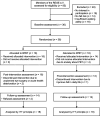Dose-response relationship of treadmill perturbation-based balance training for improving reactive balance in older adults at risk of falling: results of the FEATURE randomized controlled pilot trial
- PMID: 40380092
- PMCID: PMC12082977
- DOI: 10.1186/s11556-025-00375-w
Dose-response relationship of treadmill perturbation-based balance training for improving reactive balance in older adults at risk of falling: results of the FEATURE randomized controlled pilot trial
Abstract
Background: The inability to appropriately react to balance perturbations is a common cause of falls. Perturbation-based balance training (PBT) is especially beneficial for improving reactive balance and shows high potential for fall prevention. However, its dose-response relationship, feasibility, and acceptability remain to be determined among older adults at risk of falling. The FEATURE study aimed to compare the efficacy of two treadmill PBT protocols with different session numbers to improve reactive balance, and to evaluate their feasibility and acceptability in this population.
Methods: In this randomized controlled pilot trial, 36 older adults at risk of falling were allocated to receive either six (6PBT) or two treadmill PBT sessions (2PBT). Reactive balance in standing (Stepping Threshold Test [STT]) and walking (Dynamic Stepping Threshold Test [DSTT]) was assessed as primary outcome at baseline (T1), post-intervention (T2), and 6-week follow-up (T3). Secondary outcomes included measures on physical, psychological, and cognitive functioning. Feasibility was assessed via PBT adherence, planned perturbations completed, and adverse events; acceptability via questionnaire. Between-group changes over time were compared using repeated-measures analyses of variance with Bonferroni-corrected post-hoc tests. Data analyses followed the intention-to-treat principle.
Results: A significant time effect was observed for the DSTT (p = 0.008), with both groups significantly improving from T1 to T2 (ps < 0.01). A significant interaction effect (p = 0.027) revealed that only the 6PBT group maintained these improvements (T1 vs. T3: p < 0.001) and scored significantly higher than the 2PBT group at T3 (p = 0.015). No significant interaction effects were found for the STT or any secondary outcome, but improvements over time were observed for dynamic balance, gait capacity, functional mobility, physical activity, concerns about falling, and executive functioning (time effects: ps < 0.05). PBT adherence, planned perturbations completed, and acceptability were high in both groups, with no significant between-group differences. No intervention-related serious adverse events were reported.
Conclusions: Findings suggest that a low number of treadmill PBT sessions can lead to task-specific improvements in reactive balance during walking, with a higher practice dose enhancing sustainability. Treadmill PBT appears feasible and well-accepted among older adults at risk of falling, regardless of sessions received.
Trial registration: DRKS00030805 ; prospectively registered December 14, 2022.
Keywords: Dose–response relationship; Exercise; Falls; Feasibility studies; Frail older adults; Patient acceptance of health care; Postural control.
© 2025. The Author(s).
Conflict of interest statement
Declarations. Ethics approval and consent to participate: The study protocol was approved by the Ethics Committee of the Medical Faculty Heidelberg (S-602/2022) and conducted in accordance with the 1964 Helsinki Declaration and its later amendments. Written informed consent was obtained from all participants prior to study inclusion. Consent for publication: Not applicable. Competing interests: The authors declare no competing interests.
Figures



Similar articles
-
Feasibility, effectiveness and acceptability of two perturbation-based treadmill training protocols to improve reactive balance in fall-prone older adults (FEATURE): protocol for a pilot randomised controlled trial.BMJ Open. 2023 Sep 4;13(9):e073135. doi: 10.1136/bmjopen-2023-073135. BMJ Open. 2023. PMID: 37666555 Free PMC article.
-
Comparing the Effects of Two Perturbation-Based Balance Training Paradigms in Fall-Prone Older Adults: A Randomized Controlled Trial.Gerontology. 2023;69(7):910-922. doi: 10.1159/000530167. Epub 2023 Mar 15. Gerontology. 2023. PMID: 36921581 Clinical Trial.
-
Perturbation-based balance training to improve balance control and reduce falls in older adults - study protocol for a randomized controlled trial.BMC Geriatr. 2021 Jan 6;21(1):9. doi: 10.1186/s12877-020-01944-7. BMC Geriatr. 2021. PMID: 33407204 Free PMC article.
-
Perturbation-based balance training for falls reduction among older adults: Current evidence and implications for clinical practice.Geriatr Gerontol Int. 2017 Dec;17(12):2294-2303. doi: 10.1111/ggi.13082. Epub 2017 Jun 16. Geriatr Gerontol Int. 2017. PMID: 28621015 Free PMC article. Review.
-
A systematic review of gait perturbation paradigms for improving reactive stepping responses and falls risk among healthy older adults.Eur Rev Aging Phys Act. 2017 Mar 2;14:3. doi: 10.1186/s11556-017-0173-7. eCollection 2017. Eur Rev Aging Phys Act. 2017. PMID: 28270866 Free PMC article. Review.
References
-
- Bergen G, Stevens MR, Burns ER. Falls and Fall Injuries Among Adults Aged ≥65 Years - United States, 2014. MMWR Morb Mortal Wkly Rep. 2016;65(37):993–8. - PubMed
-
- World Health Organization. Step Safely: Strategies for Preventing and Managing Falls across the Life-Course. Geneva: World Health Organization; 2021.
LinkOut - more resources
Full Text Sources

